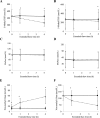Addition of Exogenous γ-Glutamyl Hydrolase Eliminates the Need for Lengthy Incubation of Whole-Blood Lysate for Quantitation of Folate Vitamers by High-Performance Liquid Chromatography-Tandem Mass Spectrometry
- PMID: 29955722
- PMCID: PMC5998367
- DOI: 10.1093/cdn/nzx003
Addition of Exogenous γ-Glutamyl Hydrolase Eliminates the Need for Lengthy Incubation of Whole-Blood Lysate for Quantitation of Folate Vitamers by High-Performance Liquid Chromatography-Tandem Mass Spectrometry
Abstract
Background: Measurement of folate monoglutamates by HPLC-tandem mass spectrometry (HPLC-MS/MS) in whole-blood lysate (WBL) requires lengthy incubation before analysis, risking degradation of labile folate vitamers.
Objective: We explored whether the addition of a commercially available recombinant exogenous γ-glutamyl hydrolase (exoGGH) enzyme reduced the required incubation time of WBL for measurement of folate as monoglutamates.
Methods: For conventional deglutamylation of polyglutamates, WBL was incubated for 4 h at 37°C. Alternatively, we added exoGGH to WBL at varying concentrations (1-10 µg/mL) and incubation times (0-90 min). We also investigated modifications to the sample diluent (pH, ascorbic acid compared with sodium ascorbate, and ascorbate concentration). Finally, we tested the effect of the enzyme in different sample types: WBL from frozen whole blood compared with frozen WBL or with frozen washed RBCs. Samples (n ≤ 15/experiment) were analyzed by HPLC-MS/MS for 6 folate monoglutamates and 5-methyltetrahydrofolate diglutamate.
Results: Optimal deconjugation of folate polyglutamates was achieved by using 1% ascorbic acid and 5 µg enzyme/mL WBL, requiring ≤30 min incubation time to achieve complete folate recovery as monoglutamates. This treatment resulted in similar folate concentrations as conventional deglutamylation (4 h at 37°C). The exoGGH enzyme was effective in samples stored frozen as whole blood and as WBL. However, the extended thaw time of whole blood resulted in 5-methyltetrahydrofolate loss and unacceptable changes to the non-methyl folate concentration. Total folate (with exoGGH) measured in washed RBCs was ∼15% lower than RBC folate calculated from WBL concentrations (conventional deglutamylation).
Conclusions: The use of exoGGH minimized incubation time and thus may avoid degradative losses of labile folate forms during sample preparation. The lower folate results in washed RBCs may be due to inadequate packing of RBCs, among other unidentified factors. A larger study is required to confirm the lack of differences in folate concentrations determined with and without the use of exoGGH.
Keywords: RBC folate; deconjugation; diglutamate; human recombinant protein; monoglutamate; washed erythrocytes.
Figures


Similar articles
-
Folate Forms in RBC and Whole-Blood Lysates Appear Stable When Stored Frozen for 2 Years.J Nutr. 2021 Sep 4;151(9):2852-2860. doi: 10.1093/jn/nxab184. J Nutr. 2021. PMID: 34091683 Free PMC article.
-
Enzymatic deconjugation of erythrocyte polyglutamyl folates during preparation for folate assay: investigation with reversed-phase liquid chromatography.Clin Chem. 1996 Nov;42(11):1847-54. Clin Chem. 1996. PMID: 8906087
-
Erythrocyte folate extraction and quantitative determination by liquid chromatography-tandem mass spectrometry: comparison of results with microbiologic assay.Clin Chem. 2005 Dec;51(12):2318-25. doi: 10.1373/clinchem.2005.053801. Epub 2005 Oct 7. Clin Chem. 2005. PMID: 16214826
-
Quantification of polyglutamyl 5-methyltetrahydrofolate, monoglutamyl folate vitamers, and total folates in different berries and berry juice by UHPLC-MS/MS.Food Chem. 2019 Mar 15;276:1-8. doi: 10.1016/j.foodchem.2018.09.151. Epub 2018 Sep 25. Food Chem. 2019. PMID: 30409571
-
Biomarkers of folate status in NHANES: a roundtable summary.Am J Clin Nutr. 2011 Jul;94(1):303S-312S. doi: 10.3945/ajcn.111.013011. Epub 2011 May 18. Am J Clin Nutr. 2011. PMID: 21593502 Free PMC article. Review.
Cited by
-
Folate Forms in RBC and Whole-Blood Lysates Appear Stable When Stored Frozen for 2 Years.J Nutr. 2021 Sep 4;151(9):2852-2860. doi: 10.1093/jn/nxab184. J Nutr. 2021. PMID: 34091683 Free PMC article.
-
Simultaneous Determination of One-Carbon Folate Metabolites and One-Carbon-Related Amino Acids in Biological Samples Using a UHPLC-MS/MS Method.Int J Mol Sci. 2024 Mar 19;25(6):3458. doi: 10.3390/ijms25063458. Int J Mol Sci. 2024. PMID: 38542431 Free PMC article.
References
-
- WHO Guideline: optimal serum and red blood cell folate concentrations in women of reproductive age for prevention of neural tube defects. Geneva (Switzerland): WHO; 2015. - PubMed
-
- Institute of Medicine Standing Committee on the Scientific Evaluation of Dietary Reference Intakes and Its Panel on Folate, Other B Vitamins and Choline Dietary Reference Intakes for thamin, riboflavin, niacin, vitamin B6, folate, vitamin B12, pantothenic acid, biotin, and choline. Washington (DC): National Academies Press; 1998. - PubMed
-
- Pfeiffer CM, Fazili Z, Zhang M. Folate analytical methodology. In: Bailey LB, editor. Folate in health and disease. Boca Raton (FL): CRC Press; 2010. p. 517–74.
LinkOut - more resources
Full Text Sources
Other Literature Sources

